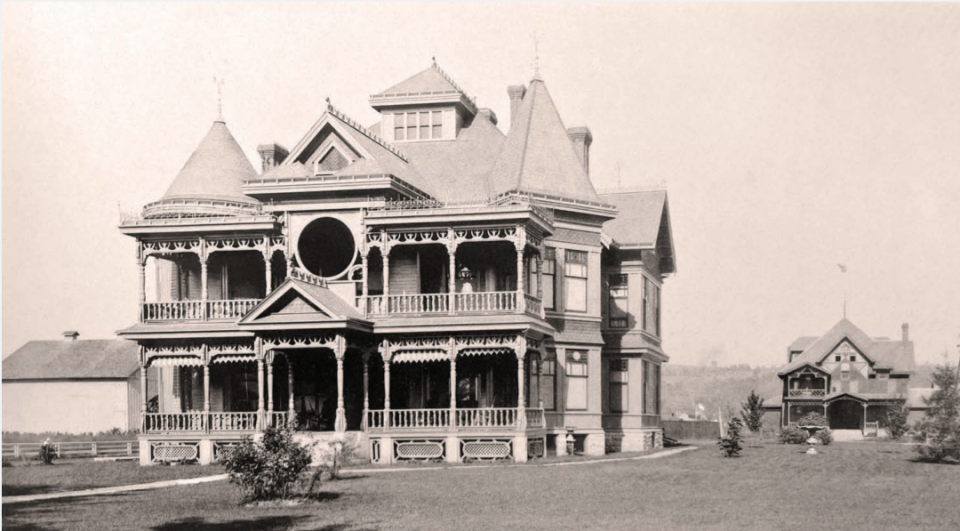'We had a millionaire in my neighborhood': Historian traces past of home in mystery photo
You know that I love mystery photos.
I recently acquired one marked “J.H. Clark” with a beautiful, opulent house. Of course, I needed to know if it still exists. It does not look familiar. So, where or what happened to the house?
Who was J. H. Clark? He was easy to find, although I’d never heard of him. He was a millionaire capitalist who lived on Elmira’s Southside. Judson H. Clark was born in Altay, N.Y. in 1839. His wife, Sadie, was a physician. In 1868, he founded the Genesee Valley Stock Farm with 225 acres in Scio, Allegany County.
They moved to Elmira in 1885 and purchased the land of Samuel W. Forman at 705 Maple Avenue (old numbering system), where he built a magnificent residence. It had 30 rooms, steam heat, electricity, gas, five bathrooms, a five-car garage, and plate glass windows, with the best material and workmanship.
Towner’s History of Chemung County books says Judson Clark and his family came to town around 1885. “[He] was a man of intelligence and wealth” who was “interested in horses of fine breeds.”
They had three children, two girls and one boy. Their daughter, Maude, was listed as a violinist in the 1890 census. In 1893, at 11 years old, she performed the difficult Wieniawski Mazurka in A Minor at Elmira College. In 1895, she played on her Stradivarius violin worth $5,000 ($184,000 today) at Elmira’s Opera House on Lake Street.

On June 4, 1891, the Elmira Gazette wrote that he was designing a “kite-shaped” mile racetrack adjoining the Inter-State Fair Grounds (also called Maple Avenue Driving Park) on Luce Street. It would be the first place in the U.S. to have one. Yet, I don’t see it on old maps, so I don’t know if it was built.
The family went to Kentucky frequently to buy and sell horses. Mr. Clark owned “the celebrated stallion General Wellington” worth $50,000. In 1892, he kept another horse, “Washington,” worth $75,000 at the stables on Luce Street. Other horses were “Bell Boy,” “St. Hontas,” and “Altie Bell.” In 1889, Clark offered $100,000 to buy “Arion” in California – with the inflation calculator today that would be $3.7 million. Mr. Clark lost the bidding to J. Malcolm Forbes, who paid $125,000 for the horse.
On May 16, 1892, the Elmira Gazette reported a fire at the Driving Park that killed five horses, including one owned by Judson Clark.
On Aug. 11, 1895, the Elmira Gazette reported that a fire burned Clark’s barns just south of the Driving Park, and he lost many horses. Someone pulled Alarm Box #58 at the corner of Spaulding and Caldwell, and the fire department quickly responded.
“The large stable contained twelve horses, hay, grain, and tools, and it was a seething mass of flames when the firemen arrived. They turned their attention to saving adjoining buildings. The fire completely consumed the stable and its contents, including twelve horses. The cause remains a mystery.”
Mr. Clark became interested in the oil fields near Latta Brook Road in 1897. Also, in 1897, the Clark family had a home in Wellsville, N.Y., to be closer to his oil fields there.
In May 1897, Clark’s well in Wellsville struck mineral water. Clark found the water had peculiar medicinal properties and should be utilized. He bottled and sold “Minneway Mineral Water.”
He must have grown tired of Elmira because, in 1897, he offered his house for $35,000 and all his land for sale in the Daily Gazette. The land was split into 270 lots for $350 each, and Phoenix and Schuyler Avenues were created on the east side of Maple Avenue to the river.
On June 26, 1897, his ad said, “Each lot had enough room for a garden to produce vegetables enough to pay interest, taxes, and a good profit. No stones, swamps, or hills.”
This enterprise was called the Maple Avenue Improvement Company. Six houses were already there. I found one of the original houses – still there at 411 Phoenix Avenue but with many changes.
On Dec. 18, 1901, the Elmira Gazette reported that a fire had destroyed the stock barn behind the house.
More: How projects will tap these Southern Tier rivers to boost recreation, tourism in region
In 1904, Mr. Clark became ill and needed an operation at the Arnot Ogden Hospital. The procedure did not go well, and he died on June 11, 1904. He is buried in Woodlawn Cemetery. His wife died two years later.
On Dec. 18, 1919, the Star-Gazette listed his house as “ideal for a clubhouse, hospital, or apartment hotel.” It was rented as a five-family home for many years.
On Oct. 24, 1921, another fire of “unknown origin” burned the remaining State Fair barns on Luce Street.
The Clark house came down in the 1950s after 30 years of neglect and decay. It never regained the opulence of its early days.
The property was sold to the Seventh Day Adventists for a new church that opened in 1959.
-- Elmira City Historian Diane Janowski writes a monthly history column.
This article originally appeared on Elmira Star-Gazette: Elmira historian traces past of opulent Southside 'mystery' home

